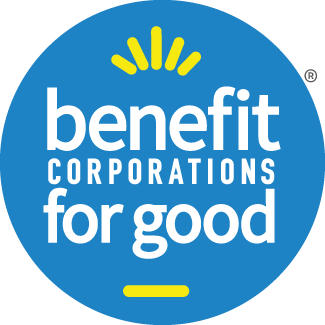Why a Portland Mission-Based Botanical Shop Chose the 3 P’s Over 501(c)3
Meet Kailia Wray and Kasia Bilhartz, co-owners of Larkspur Botanicals Portland, who share their love of plants and horticultural therapy with the people of Portland, Oregon. Larkspur is a certified Benefit Corporation for Good.
When Larkspur Botanicals was in the pre-launch stage, its two conscientious leaders believed they would become a 501(c)3. After all, mission-driven businesses like Larkspur almost always choose non-profit as a business structure.
But along the way, co-owner Kasia Bilhartz got exposed to the Oregon Benefit Company and saw it might be a better fit. During her work with many nonprofits, she saw how the majority of them were competing for the same funding pie. She recognized the freedom and ease to finance their business and community work other than through grant-writing for foundation dollars. It’s no wonder choosing the benefit corporation route for mission-based business is trending.
Now Larkspur is off and running in the Foster-Powell neighborhood of Portland. The shop not only offers healthy, resilient and verdant plants for homes and business but also provides monthly therapeutic horticulture group sessions with local partner organizations.
We recently interviewed Kasia about becoming a certified Oregon Benefit Company. Here’s what she had to say about it, the motivation for doing it and why it was right Larkspur.
1. What motivated you to become a Benefit Company?
Larkspur was initially intended to be a non-profit/501(c)(3) organization, with a mission to provide low and no cost therapeutic horticulture programming to the community. As part of my professional development, I worked and interned with some fantastic local non-profits whose missions aligned with equitable nature access and environmental education. The knowledge that my non-profit would be competing for some of the same funding pools as these orgs was the biggest influence in my changing course to operate under an LCC/Benefit Company structure. I liked the freedom and ease of starting a partnership LCC and the ability to raise our own resources/funds (to fund the community horticulture therapy programming) more directly through sales at our shop than through grant-writing and fund-raising.
I wanted to have the accountability of maintaining status as a Benefit Company as a way to communicate to the broader community that we are a mission-based business.
2. Was it difficult getting internal support for moving toward this model?
Not at all. My partner Kailia was 100% on-board with certification from the moment I pitched the idea.
3. How long did it take you to officially become a Benefit Company?
Due to Covid, there was an unexpected delay of several months between our initial contact with Tom (late 2019/early 2020), which also halted our pop-up markets and our HT programming until summer when we were able to participate in outdoor markets. Once we finally signed up for the exam/application, we were processed and certified within about a month.
4. Have you seen any change in culture since you became a Benefit Company?
We were certified a month prior to opening our brick & mortar shop and doing this full-time, so being a Benefit Company is part of our foundational bedrock. As such, our culture is built on these principles.
5. Have you experienced any positive outcomes since becoming a Benefit Company?
Yes, absolutely. We have had many customers inquire about our work and mission after seeing our signage or seeing on our website that we are certified. These inquiries give us a natural opportunity to talk about therapeutic horticulture, and about the programming that we provide. It also opens discussions about the healing power of plants and nature. These conversations often lead to smiles, offers of support, and meaningful participation.
6. Would you recommend this business model to others? Why or why not?
Yes, we would recommend it! If a business is at all inclined to be a benevolent presence in their community, becoming certified as a Benefit Company provides guidance and support on how to do so, and communicates those intentions and practices to the public, which is meaningful to customers and collaborators.
7. What is the most important trait to have as a conscientious leader of a Benefit Company?
We believe the most important trait is a firm commitment to amplify goodness, and in that, to limit harm.
8. What lessons have you learned in the process?
We have learned that, even with a physical presence in an urban area, it is really vital to engage our community online, a lesson that we’ve been grateful to get as a part of our certification process with Tom and Mary Anne of Benefit Corporations for Good. We are still working on this lesson!
9. Is being a Benefit Company part of your current brand message?
Absolutely. We are very proud to share that we are certified. We share our badge on our website, in our store, on our business cards, and in all applicable communications. It is a big part of our identity.
10. What is the single best reason you'd give for another company or peer to become a Benefit Company?
There is a quote by Marshall McLuhan provides a beautifully concise answer to the “why.” It suggests that all hands are needed to help the planet and people right now. We all have skills and talents to contribute to lifting one another up. Becoming a Benefit Company is a step in becoming a part of the solution.
The quote:
“There are no passengers on Spaceship Earth. We are all crew.”
You can learn more about Larkspur Botanicals Portland here.
If you want to know more about why your business should become a benefit corporation, watch this.
Learn more about the 6 simple steps to becoming a benefit company or benefit corporation here.
~benefitcorporationsforgood.com~

